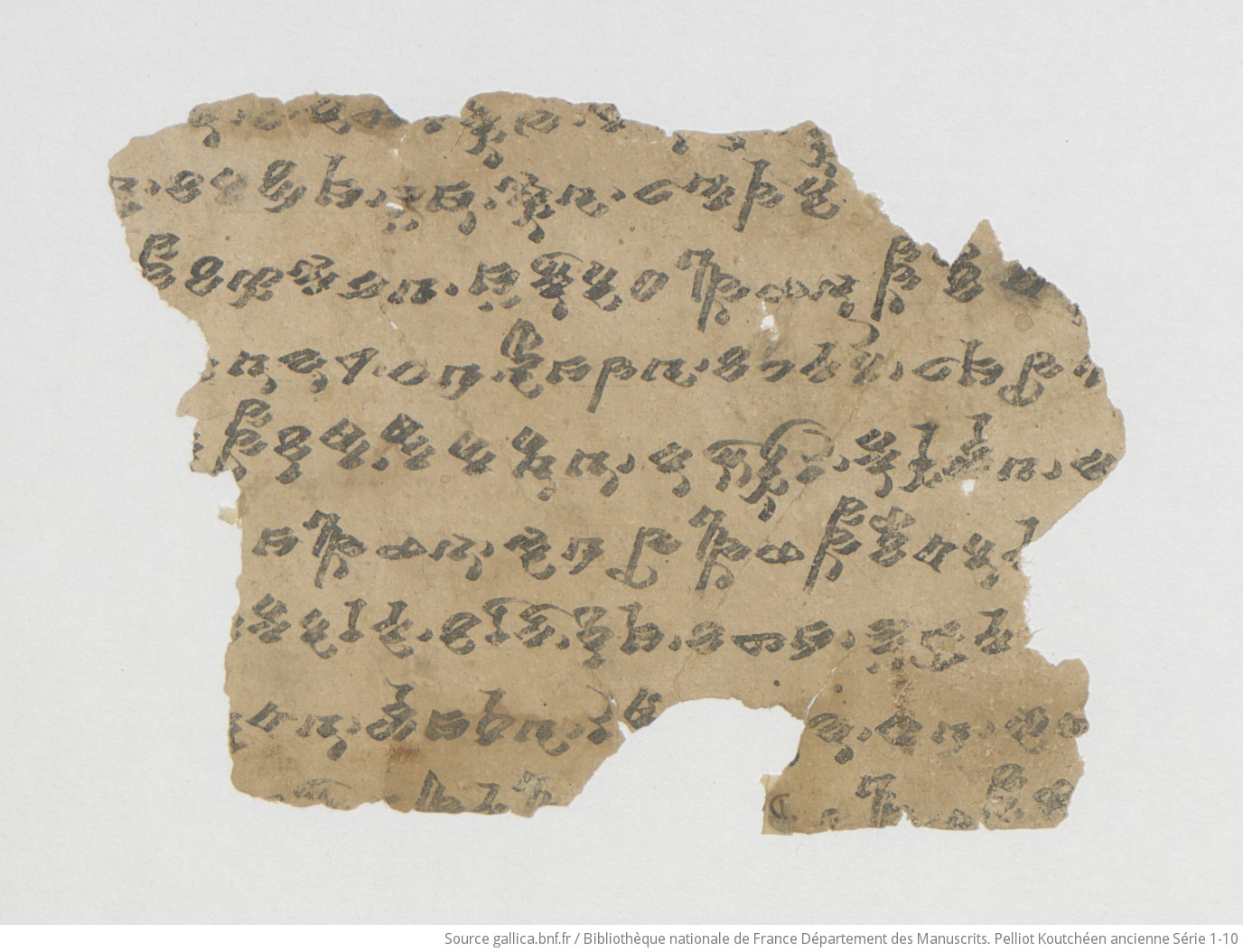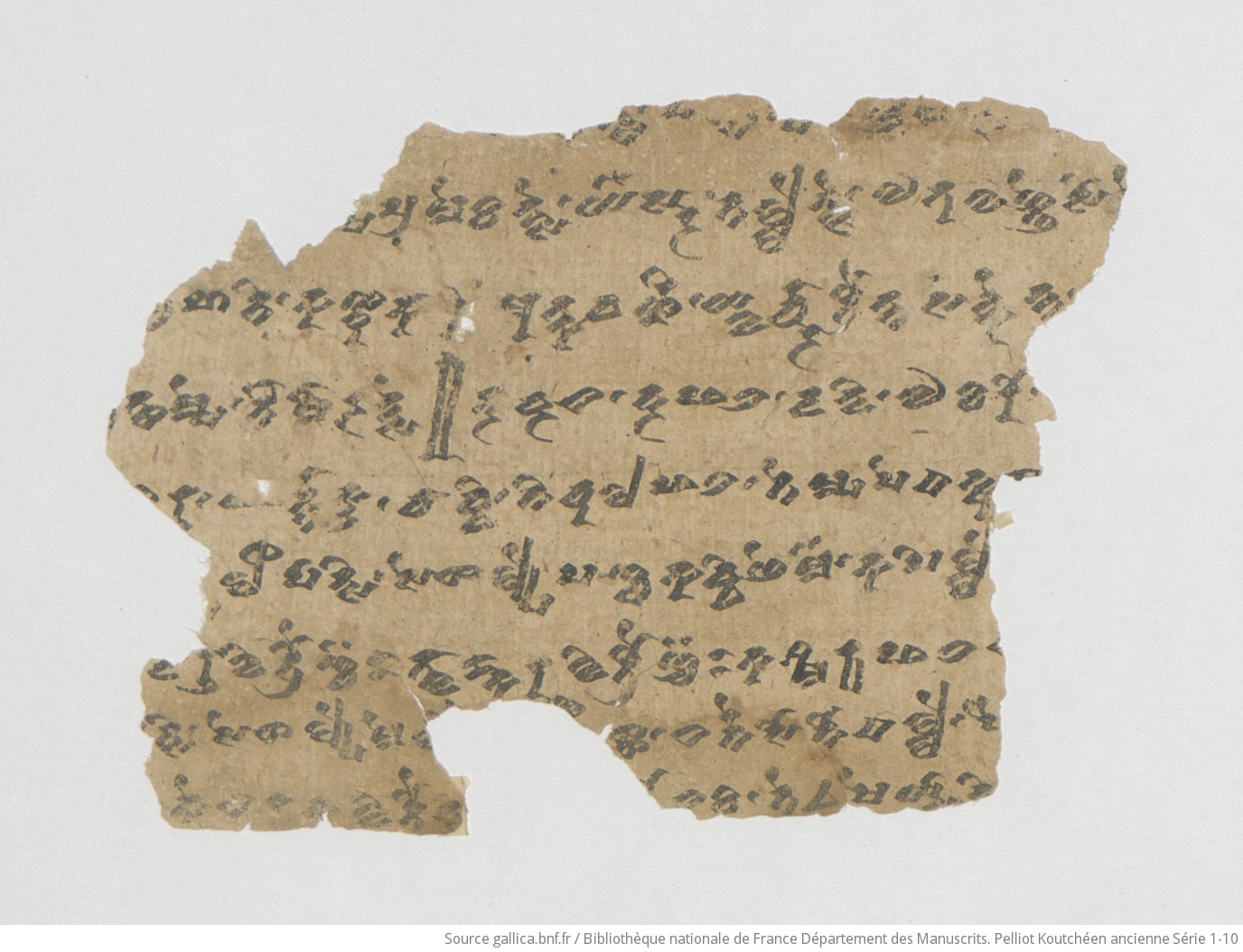Work in progress
PK AS 9A
| Known as: | PK AS 9A; Pelliot Koutchéen Ancienne Série 9A; P 3 |
|---|
| Cite this page as: | Georges-Jean Pinault; Melanie Malzahn (collaborator); Michaël Peyrot (collaborator). "PK AS 9A". In A Comprehensive Edition of Tocharian Manuscripts (CEToM). Created and maintained by Melanie Malzahn, Martin Braun, Hannes A. Fellner, and Bernhard Koller. https://cetom.univie.ac.at/?m-pkas9a (accessed 16 Jul. 2025). |
|---|
Edition |
| Editor: | Georges-Jean Pinault; Melanie Malzahn (collaborator); Michaël Peyrot (collaborator) |
|---|
| Date of online publication: | 2014-02 |
|---|
Provenience |
| Main find spot: | Duldur-akur |
|---|
| Specific find spot: | cour |
|---|
| Expedition code: | DA cour |
|---|
| Collection: | Bibliothèque nationale de France, fonds Pelliot Koutchéen (Paris) |
|---|
Language and Script |
| Language: | TB |
|---|
| Linguistic stage: | archaic |
|---|
| Script: | classical |
|---|
Text contents |
| Text genre: | Literary |
|---|
| Text subgenre: | Medicine/Magic |
|---|
| Verse/Prose: | prose |
|---|
Object |
| Manuscript: | PK AS 9 |
|---|
| Material: |
ink
on paper |
|---|
| Form: | Poṭhī |
|---|
| Size (h × w): | 9.5 × 12.5 cm |
|---|
| Number of lines: | 9 |
|---|
| Interline spacing: | 1.2 cm |
|---|
Images
Transliteration
| a1 | /// [k]s̝a ll· s̝a lyp· – (– – – –) [lyp](·) k(·) ly(·) – (·)ñ(·) – /// |
|---|
| a2 | /// h(·) ṇi • pā tha • we (·)[e] (–) (·)ś(·) ra • pi cu ma ṇḍa • pe pa [rṣ](·) /// |
|---|
| a3 | /// ka bī jä • mā śa ka • mu rvva • ku ru ci • ki ra ti kta – /// |
|---|
| a4 | /// k(·) te pa ks̝a lle s̝a lype li pā tsi • se s̝a lype ma /// |
|---|
| a5 | /// na • pa ṇḍa ro kne • ra trau ñai ne • pe ṣte nta tsa • tsa rka lle – /// |
|---|
| a6 | /// [p]pa li mu la • tra ka ṭ[u] ka • pi la ma ddhyi • pā tha • e we pe – /// |
|---|
| a7 | /// [l](·) pa ks̝a lle se s̝a lype dha ni kñe mä • pa nā ksa yo ka ll(·) /// |
|---|
| a8 | /// ni lu tpa la • pi ssau • me [d]ä • mu ñcā ta ka • [rṣa] /// |
|---|
| a9 | /// (·)au (–) (·)ī (·)e nta • o k[t](·)au – pha ni ta • [k]e /// |
|---|
| b1 | /// tsa [•] [p](·) tta [tsa] (–) [ku](·) [m](·) [tsa] /// |
|---|
| b2 | /// (·)ṣ(·) pra me ka ntse • yä sa¯ ¯r • ta lle ntse • o nu wa ññe sāṃ (·)(·)e /// |
|---|
| b3 | /// (·)[r](·) ha ti • ka ṇḍa ka ri[ṃ] mu tka va rṇi • ywa rcā¯ ¯r trau nta saṃ tke nta • /// |
|---|
| b4 | /// tsa mṣe • tī mī ra ntse || tra vra ta • tra pha la • da ndi • o ka ro • /// |
|---|
| b5 | /// (·)ā ru • [śa] rttā [kru] • cā vvi • ni cu la pha¯ ¯l • te mpa pe pa kṣu [s̝a] /// |
|---|
| b6 | /// li pā tsi • se s̝a lype pa ñca ka vvi ñe mä • ka pi lle /// |
|---|
| b7 | /// d(·) ru wi trau ñcä 2 tvā ṅka ra¯ ¯ñ wi trau ñcä 2 ka śma rya pha la – /// |
|---|
| b8 | /// tsi • se s̝a lype me [l](·)[e] (– –) s̝s̝a • ta rne so no pa lle • pai /// |
|---|
| b9 | /// ke ta ra ka wi trau ñc(·) (– – –) (·)[au] na ka • te e ṣe y[s]ā ·i /// |
|---|
Transcription
Translation
| a1 | ... [is] to be cooked. Oil ... |
|---|
| a2+ | ... (Helleborus) niger, Cissampelos pareira (Skt. pāṭha-), Trigonella foenum (graecum), Vaśira [flower or salt], Azadirachta indica, (root) of pipär ... seed of (Holarrhana) antidysenterica, bean, Sanseviera zeylanica, Tinospora cordifolia, Agathotes chirata, ... |
|---|
| a4 | ... this [is] to be cooked so that oil is left over. This oil ... |
|---|
| a5 | ..., in case of jaundice, in case of redness, for the ones [infested with] worms, (for the ones) afflicted by heat ... |
|---|
| a6 | ... root of Piper longum, the three spices, the heart of the fruit of Aegle marmelos, Cissampelos pareira, [outer] skin (?) ... |
|---|
| a7 | ... [is] to be cooked. This oil is called the rich one [= Skt. dhānika-], it [is] to be drunk as a potion ... |
|---|
| a8+ | ... Nymphea stellata, aneth, Polygonatum verticillatum, Saccharum munja, Microstylis (muscifera) ... tr(au) [of] sa(liva) (?), eight trau [of] syrup, ... |
|---|
| b1 | ... for the ..., for the gal [diseases], for the abdomen tumors, ... |
|---|
| b2 | ... for urine disease, for blood suffering, [this is] the invincible remedy ... |
|---|
| b3 | ... Solanum indicum, Solanum xanthocarpum, Phaseolus trilobus, [in quantities of] half a trau per remedy ... |
|---|
| b4 | ... for growing sight disorder. |
|---|
| b4+ | Ipomoea turpethum, the three myrobalans, Croton polyandrum, Acorus calamus, ... deodar, boiled rice, Piper chava, fruit of Calamus rotang: |
|---|
| b5 | with that cooked o(il) ... |
|---|
| b6 | ... (so that an oil) [is] left over. This oil is called pañcakavvi (= Skt. pañcagavya 'five products of the cow'). (In case of) fever ... |
|---|
| b7 | ... two trau of deo(dar): 2, two trau of ginger: 2, fruit of Gmelina arborea ... |
|---|
| b8 | ... (so that an oil is left) over. This oil (reache)s the nos(trils). The crown of the head [is] to be anointed. ... |
|---|
| b9 | ... for anyone indeed two trau ... during (one wee)k. This together with ... |
|---|
Commentary
Linguistic commentary
| * | The language is archaic TB, but the ductus is rather an early classical form that lacks the characteristic shibbolets of the archaic script type. This text is an older version, the Berlin one THT 497 is younger, cf. also the use of the dual wi trauñc vs. plural wi traunta. |
|---|
Parallel texts
Philological commentary
| * | This fragment is close to THT 497, but not a direct parallel. |
|---|
| n1 | The reading and restoration pepä[kṣu] by Filliozat is impossible since the upper part of the akṣara is to high for a ka. Furthermore one does not expect a PPt at the beginning of a clause. In addition, a phrase pepärṣṣa witsäko recurs in PK AS 9C b3. |
|---|
| n2 | Pace Filliozat, one has to read paṇḍarokne for Skt. paṇḍuroga- 'jaundice, lit. yellow disease'. |
|---|
| n3 | dhanik is certainly a loan from Skt. dha/ānika- 'rich, opulent' rather than 'coriander' in the present context. |
|---|
| n4 | panāk is certainly a loan from Skt. pānaka- 'beverage, potion' (rather than Skt. panaka- 'arum lily', which is poisonous). In this case, we should have a perlative of manner. |
|---|
| n5 | One has to read tallentse, not tillentse, pace Filliozat. This forms calls to mind talle* 'burden, load'. One may surmise a pseudo-compound 'burden pertaining to blood'. It may be a calque of a Sanskrit compound. |
|---|
| n6 | Since a form tsämṣe gives no known word, one may surmise that the scribe omitted an akṣara, hence tsämṣe‹ñcai›. |
|---|
| n7 | One has to read śärttākru, a variant of śärtākru found in THT 497 b8. It is certainly a loan from Sanskrit that can be restored as śṛta-kuru- 'boiled rice'. |
|---|
| n8 | We expect a verbal form ending in ṣṣä〈ṃ〉. Unfortunately, it cannot be a form of pin- 'blow (into the nose)', because we would expect a subjunctive. A possibility is to restore (yänmā)ṣṣäṃ 'reaches', maybe as a cure involving inhalation. |
|---|
| n9 | ysā may be the start of a compound 'golden-x' or alternatively a noun with prefix yä(n)-. |
|---|
Remarks
| * | A fragment from the middle of a leaf. Recto and verso side cannot be determined. |
|---|
Alternative linguistic/paleographic classifications
References
Edition and translation
Filliozat 1948: 53-54; Sieg and Thomas 1954: 69-70
Bibliography
Filliozat 1948
Filliozat, Jean. 1948. Fragments de textes koutchéens de médecine et de magie. Texte, parallèles sanskrits et tibétains, traduction et glossaire. Paris: Librairie d’Amérique et d’Orient Adrien-Maisonneuve.
Peyrot 2008
Peyrot, Michaël. 2008. Variation and change in Tocharian B. Vol. 15. Leiden Studies in Indo-European. Amsterdam/New York: Rodopi.
Sieg and Thomas 1954
Sieg, Emil, and Werner Thomas. 1954. “Die medizinischen und tantrischen Texte der Pariser Sammlung in Tocharisch B.” Zeitschrift für Vergleichende Sprachforschung 72: 63–83.
Tamai 2011
Tamai, Tatsushi. 2011. Paläographische Untersuchungen zum B-Tocharischen. Innsbrucker Beiträge zur Sprachwissenschaft 138. Innsbruck: Institut für Sprachen und Literaturen.




